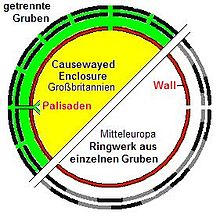Henges from Wyke Down
The Henges of Wyke Down are south of the A354 (road) on the chalk plateau Cranborne Chase, southwest of Salisbury in England .
The Henges Wyke Down 1 (WD1) and Wyke Down 2 (WD2) are causewayed enclosures and were spotted in aerial photographs. However, they were not immediately recognizable as such from the air, so it is conceivable that this type of monument is more widespread in the region than assumed. The geophysical survey of six grave mounds belonging to the Wyke Down group showed that half of them have mines (interrupted trenches), suggesting Neolithic origins. The Henges form two groups: those at Knowlton and those with Cursus . The small close-by Henges WD1 and WD2 were excavated in 1983-4 and 1996.
Wyke Down 1 (WD1)
WD1 is a ring with a diameter of 20 m, which consists of closely spaced pits separated by narrow webs, which were picked out of the chalk underground. The three meter wide gap in the entrance to the interior faces south. The narrow dams are somewhat eroded, creating the impression of a moat that is interrupted by the only access. The oval pits are 1.35–2.0 m deep and about two meters long, with the exception of the western pit, which is twice as large. The picked material was used to build an outer wall, of which hardly any traces have survived. After completion, a number of objects were brought into the pits. These include the antler shoots of a red deer , animal bones, flint, and worked pieces of chalk.
The pits were then half filled with chalk rubble over the course of five years. During this time, small pits were dug in the fill layers, into which a number of ritual objects came. These differed significantly from those on the lower level. They contained a lot of Grooved Ware type pottery and small amounts of human bones. The upper retention were eventually covered and a clayey silt layer came into the pits in which shards of late-Style Beaker pottery and pieces of collar urns found (Collared Urn).
These sherds, which were also found in WD2 and in a pit in the center of WD1, indicate late use, dating back to around 3460 BC. BC could be dated. These activities presumably took place while the nearby Henge WD2 was under construction. The majority of the finds from WD1 are concentrated in the access area. This includes shards of grooved goods, vessels and a cross-edged arrowhead in the pits on both sides of the entrance. A fragment of an interior decorated bowl and a small stone ax from Group VIII from South Wales lay in the western pit. Some significant finds from pits at the rear suggest that the axis of the monument has been carefully marked.
Wyke Down 2 (WD2)
WD2 has a diameter of only 12 m and was built from two segments - a semicircular west side and a banana-shaped east side. Where the two meet at the northern end is a very narrow, weathered footbridge. At the southern end is the two-meter-wide access dam. WD2 also consists of a series of oval pits. 10 lie on the fully excavated semicircle on the west side. The pits have a maximum depth of 1.75 m. In contrast to WD1, the footbridges only survived on the trench bottoms up to a maximum height of 56 cm. This suggests that they did not completely separate the pits.
As with WD1, the southwest pit housed a special depot consisting of an organic deposit on the base of an essentially complete Grooved Ware type vessel of extraordinary shape. Decorative motifs of all three types of Grooved Ware and an additionally decorated base were found as well as small pearl balls that were applied to the edge at intervals. Carbonized food residues stuck to the inner surface. On the floor of the northwest pit, shards of Peterborough ware (an unusual combination with grooved ware) were found. There was a small chalk ball at the base of another pit.
In 2000 another discovery was made at Wyke down. Two large stones were plowed in the south henge of Knowlton , in Dorset, four kilometers away . The stones come from the Wall des Henges. One stone shows petroglyphs like a sunstone . The stones appear to be iron-rich sarsen stones that are found a few kilometers away on the edge of Tertiary deposits. The ornate stone is rectangular, about 105 cm long, 60 cm wide and 18 cm thick, and has a design of four concentric rings in the center . It is reminiscent of concentric circles that appear on Grooved Ware. The rather rare motif has been found on at least four vessels from the Henge WD1 and in two post holes and a pit outside the Henge WD2.
literature
- Richard Cavendish: Prehistoric England . Weidenfeld and Nicolson, London 1983, ISBN 0-297-78315-7 , ( Discover England ).
Individual evidence
- ↑ The Cranborne Chase are in Dorset, Hampshire and Wiltshire
Web links
Coordinates: 50 ° 56 ′ 13.9 " N , 1 ° 59 ′ 33.8" W.

